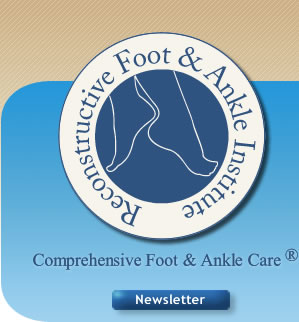Tarsal Tunnel Syndrome
![]() NBC25 Medical Corner Tarsal Tunnel Syndrome — Dr. Michaels »
NBC25 Medical Corner Tarsal Tunnel Syndrome — Dr. Michaels »
Tarsal Tunnel Syndrome (TTS) is a very common disorder and is associated with heel pain. It is mainly caused by diabetes, obesity, alteration in gait and trauma. Symptoms can include numbness, heel pain, sharp shooting pain in the ankle, electric type pain, pins and needles, numb toes and tingling toes. Often times TTS is misdiagnosed as Plantar Fasciitis because they both cause heel pain.
TTS produces symptoms because of a pinched nerve in the ankle. The Posterior Tibial (PT) Nerve is a large nerve the thickness of a pencil that courses behind and on the inside of your ankle. There is a ligament overlying this nerve that can become tight. Furthermore, a muscle on the inside of your foot lies on top of the PT nerve and can pinch it in this area. There is a small branch of the PT nerve that goes under your heel by the heel spur and can be pinched in this area from the soft tissues present in this area of the foot.
It takes a very skilled doctor to determine if you have a pinched nerve or not. If your doctor suspects that you do have a pinched nerve a test may be ordered to determine how bad it is being pinched. If the test is positive then your nerve is pinched and will need treatment. The test is called a Nerve Conduction Velocity (NCV) test and can be done in your doctor’s office. The NCV test is non invasive, meaning that there are no needles.
Conservative treatment consists of injecting steroid or alcohol in the area of the nerve. The steroid can decrease inflammation and alcohol can decrease pain over time. Orthotics are shoe inserts that can support the foot and decrease pain associated with this disorder. An Air Heel can also decrease pain by padding the foot. A night splint can be used to hold the foot in the proper position thus decreasing pressure on the nerve. There are certain medications which work very effectively against heel pain. Tape may also be applied to the foot to decrease the nerve pain. Most people get better with conservative care with some combination of the above treatments.
If conservative treatments fail then it may be necessary to release the nerve from its overlying entrapment surgically. This will require 20-30 minutes to accomplish. You can be awake or asleep for the procedure and can discuss these options with your Foot Surgeon. The recovery takes about 3-4 weeks and you will need a special walking boot and crutches to recover and to prevent any complications. You can ambulate with a special cast boot and sometimes crutches the day of your surgery. The pain from the pinched nerve may go away immediately or may take several months to subside. Once the nerve is released it actually grows back to a normal nerve at a rate of 1 inch a month.
